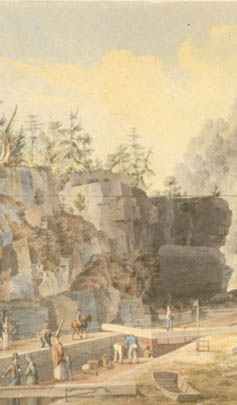

Yet it is not that wealth now enriches the scene
Where treasures of Art and of Nature convene;
It is not that this Union our coffers may fill:
Oh! No! It is something more exquisite still.
‘Tis that Genius had triumphed and Science prevailed
Where prejudice flouted and envy assailed
It is that the Vassels of Europe may see
The Progress of Mind in a Land that is free.
-- from The Meeting of the Waters of Hudson and Erie, by Samuel Woodworth, 1825; sung by Mr. Keene at the Grand Canal Celebration, respectfully dedicated to His Excellency, DeWitt Clinton.
The Erie Canal, begun in 1817, was a triumph of early engineering in the United States and one of the most ambitious construction projects of nineteenth-century America. It was longer by far than any other canal previously built in Europe or America, crossing rivers and valleys, cutting through deep rock, and passing through marshes and forests in its 363-mile course across New York State. Throughout the nineteenth century, the Erie Canal underwent enormous changes and expansions in response to its overwhelming popularity as a means of travel and transport. These additions and revisions are documented by thousands of engineering maps and drawings created over the course of the century.
The driving force behind the canal project was DeWitt Clinton, former mayor of New York City and Governor of New York State. Completed in 1825, the original Erie Canal is often referred to as "Clinton's Ditch." It was forty feet wide and four feet deep. Ten years after its opening, the Erie Enlargement was begun, built in response to the immediate overcrowding of the original canal. The Enlargement expanded the canal to seventy feet wide and seven feet deep. In 1903, a third canal was begun, known as the Barge Canal. Completed in 1918, it used a new route in many places and required no towpath, as the boats were self-propelled instead of drawn by horse or mule. The Barge Canal is still in use today
From the opening days of the canal in 1825, thousands of people from America and Europe took advantage of the new inland waterway and its faster, smoother mode of travel. Thousands more were employed on the canal operating cargo boats that transported goods such as salt, flour, or textiles between Buffalo and New York City. Many of the sights and sounds of the Erie Canal were recorded by those who worked and traveled on it during its heyday. Travelers wrote about their experiences and impressions in private journals or in travelogues that were then published. Artists created images of the canal in prints and paintings, and popular magazines like Harper's Weekly and Frank Leslie's Illustrated Newspaper ran stories and printed canal images throughout the nineteenth century.
In the year 2000, on the occasion of the 175th Anniversary of the opening of the Erie Canal, the Mandeville Gallery of Union College, Schenectady, NY, put together an exhibition in three parts entitled "Monument of Progress". The exhibition was curated by Rachel Seligman, Director/Curator, Mandeville Gallery, with paintings and prints from various collections, and models created by Union College students. The exhibition ran from September 4 to October 29, 2000, and a core portion of the exhibition is now traveling throughout New York State.
The exhibition offered viewers a chance to see engineering drawings of the Erie Canal, along with prints and descriptions of canal sights. The drawings provided an introduction to the complex structures of the canal as recorded by those who built it. The prints and descriptions provided additional views of these structures as recorded by those who traveled its waters.
This section of The Erie Canal site comprises most of the web pages created by the Web Staff of Union College for the Exhibition, as well as supplementary material prepared by the Gallery staff. These pages contain much information about the history and construction of the Erie Canal, as well as a number of reproductions of the paintings and prints from the Exhibition.
NOTE: Most images on the main pages are clickable. Clicking on the small image will take you to a page with the full-size image as well as information about that image. Supplementary text can be found on some pages by clicking on the Additional information link and the Extracts from the Diary of Jonathan Pearson link.
The Erie Canal site wishes to thank Rachel Seligman and Kim Wallace of the Mandeville Gallery, and Tom Smith, Web Director for Union College, for their permission to use these pages, images and texts as well as their invaluable help in making it possible!
http://www.eriecanal.org/UnionCollege/175th.html